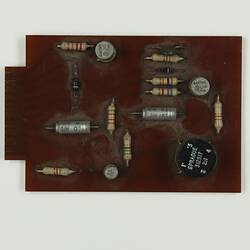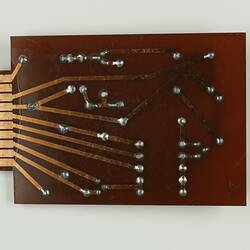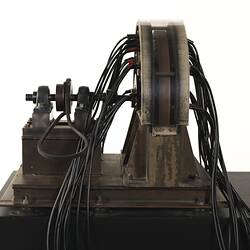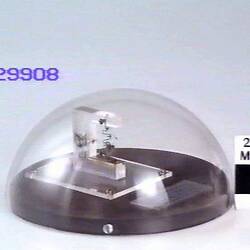Summary
One of two circuit boards acquired.
These circuit boards were two of about 20 circuit boards connected to the read heads of the magnetic disk store of the CSIRAC computer; there were 20 heads. The circuitry, which included the boards, was part of the first attempt to design transistor based read amplifiers to extend the capacity of the drum. Each circuit board was part of a chassis.
The circuitry was designed and built by Jurij Semkiw, in the early 1960s, to extend the capacity of the magnetic disk store. Low power transistors and simple printed circuit boards were used in the circuits developed to read data from the electro-magnetic read heads. However, due to the high cost of the higher power transistors, vacuum tubes were still used for the write circuitry, which recorded the magnetic signals onto the disk. However, it is not installed in CSIRAC as displayed at Museum Victoria (2006), since the policy is to exhibit the computer as it was in 1956 when it was re-commissioned in Melbourne rather than as it was at the end of its working life.
The drum/disk was originally designed to hold 1024 words on one side of the disk and the same number on the other side. Only one side could be implemented at any time. An electro-mechanical switch was installed to toggle from one side to the other, but never used. The method adopted was to do this electronically using a combination of transistorised and valve circuitry.
Physical Description
Two rectangular brown plastic circuit boards with a tab on one side. One side has copper tracking leading to a series of connectors on the tab. The tracking appears to be the same on each board although there are differences in soldering. On the other side to the tracking, the general layout of the components is the same except for the diodes.
Significance
These circuit boards represent a transition from electronic valve to transistor technology. It is also interesting that the pre-transistor computer, CSIRAC, could also work with transistor circuitry.
More Information
-
Collection Names
-
Collecting Areas
-
Acquisition Information
Donation from Computer Science & Software Engineering Department, University of Melbourne (The), 10 Apr 2012
-
Creator
University of Melbourne (The), Grattan Street, Parkville, Greater Melbourne, Victoria, Australia, circa 1962
-
Date Made
-
Format
Book
-
Inscriptions
Tracking side of one board: 2. Tracking side of other board: 12 Components have identification, either text, rings or colour.
-
Classification
Computing & calculating, Digital computing, Paperwork & documentation
-
Category
-
Discipline
-
Type of item
-
Overall Dimensions
105 mm (Length), 70 mm (Width), 17 mm (Depth)
Dimensions of each card
-
Keywords
Computers, Computing, CSIRAC (Computer), Making History - CSIRAC





